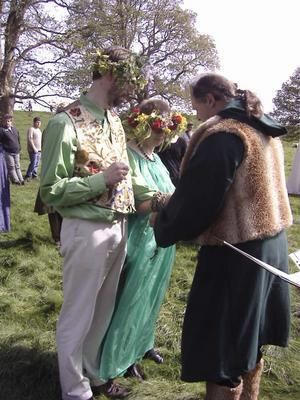 | ||
Handfasting is a rural folkloric and neopagan custom, initially found in western European countries, in which a couple hold a commitment ceremony. The commitment may be seen as temporary and secular, or of a longer, spiritual variety, depending on the context.
Contents
Origin of the term
Handfasting is a historical term for "betrothal" or "wedding". In the Early Modern history of Scotland (16th and 17th centuries), especially in the Hebrides, the term could also refer to a temporary marriage.
The verb to handfast in the sense of "to formally promise, to make a contract" is recorded for Late Old English, especially in the context of a contract of marriage. The derived handfasting is for a ceremony of engagement or betrothal is recorded in Early Modern English. The term was presumably loaned into English from Old Norse handfesta "to strike a bargain by joining hands"; there are also comparanda from the Ingvaeonic languages: Old Frisian hondfestinge and Middle Low German hantvestinge. The term is derived from the verb to handfast, used in Middle to Early Modern English for the making of a contract.
The term "handfasting" or "hand-fasting" has been in use in Celtic neopaganism and Wicca for wedding ceremonies from at least the late 1960s, apparently first used in print by Hans Holzer.
Handfasting was mentioned in the 1980 Jim Morrison biography No One Here Gets Out Alive and again in the 1991 film The Doors, where a version of the real 1970 handfasting ceremony of Morrison and Patricia Kennealy-Morrison was depicted (with the real Patricia Kennealy-Morrison playing the Celtic Pagan priestess).
"Handfasting ribbon" custom
The term has entered the English-speaking mainstream, most likely from Neopagan wedding ceremonies during the early 2000s, often erroneously being described as "pre-Christian" by wedding planners. Evidence that the term "handfasting" had been re-interpreted as describing this ceremony specifically is found in the later 2000s, e.g. "handfasting—the blessed marriage rite in which the hands of you and your beloved are wrapped in ribbon as you 'tie the knot.'" By the 2010s, "handfasting ceremonies" were on offer by commercial wedding organizers and had mostly lost their Neopagan association (apart from occasional claims that attributes the ceremony to the "ancient Celts"). The term "handfasting ribbon" appears from about 2005.
